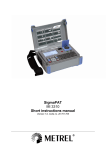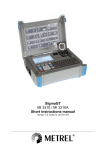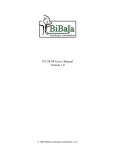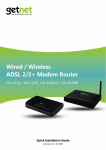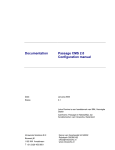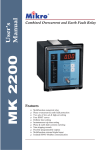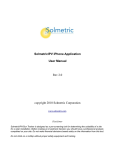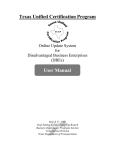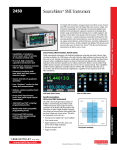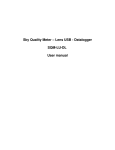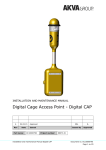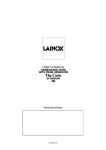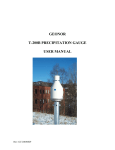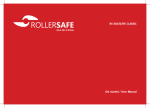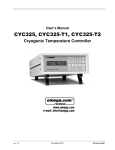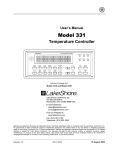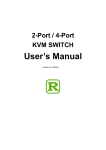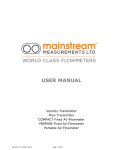Download User Manual Protection and Control refleX 201
Transcript
kjøter Protection and Control refleX 201 Overcurrent protection Communication IEC 60870-5-103 User Manual 201_PRD_33A_UK.DOC Document type: Page: User Manual 2 of 19 Document name: Document no: Prep.: RefleX 201_PRD LIER - NORWAY App.: File: I:\UTVIKLIN\Arc57114\SW57114\App\201_I\201_prd_33a_UK.doc EOJ 33a Date: Var.: 18. nov.. 2010 1 Content USER MANUAL ........................................................................................................................................ 1 TU UT 1 TU CONTENT ................................................................................................................................. 2 UT TU UT 2 TU HARDWARE DESCRIPTION ................................................................................................ 3 UT TU 2.1 2.2 2.3 2.4 2.5 UT UT TU TU UT TU TU UT TU UT TU UT HARDWARE DESIGN ..................................................................................................................... 3 HARDWARE REPLACEMENT ......................................................................................................... 3 FRONT PANEL ............................................................................................................................... 4 REMOTE OPERATION AND READOUT ............................................................................................. 5 REAR CONNECTIONS .................................................................................................................... 5 TU UT UT TU UT TU UT UT 3 TU TU MENU......................................................................................................................................... 6 UT TU 3.1 3.2 3.3 3.4 3.5 3.6 3.7 3.8 UT UT TU TU UT TU TU UT TU UT TU UT TU UT TU UT TU UT NAVIGATION ................................................................................................................................ 6 CHANGE A SETTING ...................................................................................................................... 6 SHOW REFLEX SOFTWARE VERSION............................................................................................. 6 CHANGE PASSWORD .................................................................................................................... 6 MAIN MENU (SETTING MENU) ..................................................................................................... 7 IN-SERVICE MENU (ONLINE MEASUREMENT MENU) .................................................................... 8 TRIP RECORDS (HISTORY MENU) ................................................................................................. 9 EVENT LOG (HISTORY MENU) ................................................................................................... 10 TU UT UT TU UT TU UT TU UT TU UT TU UT UT 4 TU TU SCHEMATIC I/O AND LOGIC ............................................................................................ 11 UT TU UT 5 TU MODULE DESCRIPTIONS .................................................................................................. 12 UT TU 5.1 5.2 5.3 5.4 5.5 UT UT TU TU UT TU TU UT TU UT TU UT OVERCURRENT DESCRIPTION (IEEE C37.2 50, 51) .................................................................... 12 COMMUNICATION/ EVENTS ........................................................................................................ 12 SETTING GROUP ......................................................................................................................... 13 BREAKER FAILURE (IEEE C37.2: 50BF) .................................................................................... 13 PASSWORD ................................................................................................................................. 13 TU UT UT TU UT UT UT 6 TU TU TU SETTINGS ............................................................................................................................... 14 UT TU 6.1 6.2 6.3 6.4 6.5 UT UT TU TU UT TU TU UT TU UT TU UT OVERCURRENT PROTECTION (IEEE C32.2: 50, 51) ................................................................... 14 COMMUNICATION (IEC 60870-5-103) ....................................................................................... 14 SETTING GROUP ......................................................................................................................... 14 BREAKER FAILURE PROTECTION (IEEE C32.2: 50BF) ............................................................... 14 SYSTEM DATA ............................................................................................................................ 14 TU UT UT TU UT UT UT TU 7 TU TU TECHNICAL DATA .............................................................................................................. 15 UT TU 7.1 7.2 7.3 UT UT TU TU UT TU TU UT ELECTRICAL DATA ..................................................................................................................... 15 ENVIRONMENTAL CONDITIONS................................................................................................... 16 DIMENSIONS AND WEIGHT.......................................................................................................... 18 TU UT UT TU UT Ver.: 201_PRD Page 3 of 19 2 Hardware Description 2.1 Hardware Design 1 Housing The extruded aluminium housing is maintenance free, and is grooved on the outside to ensure a secure grip during handling. The circuit board guides are integrated in the housing and symmetrically located to enable the housing to be turned in any direction before mounting the circuit boards. 2 Front panel frame The front panel frame has standard 4U height (177 mm). If mounted in 19" cubicles a special mounting frame containing up to 4 RefleX units is available. The relay may of course also be mounted into an traditional protection panel. 3 Front panel module This module forms the base of each system unit when mounted. The multilayer front cover with the 16-key keypad is attached to a galvanised steel-plate. The mother board, the LCD-display and the D-sub connector are permanently attached to the steel plate. Disassembly is not recommended. 4 Measuring module This module is plugged directly into the front panel module. At the measuring module a dedicated microprocessor is used for signal conditioning and pre-filtering. The module handles up to seven input channels like currents and/or voltages. The resulting values are streamed through the front panel module to the processor module (6). 5 I/O and power module This module consists of 1 1/2 circuit boards including all digital input/output insulation circuits (optical isolators and output relays), as well as the unit’s power supply. The module is plugged into the front panel module. The smaller input board is “piggy-back” mounted on top of the output/power board. Both circuit boards are permanently assembled, and should be handled as a single module. Disassembly is not recommended. 6 Processor module This module contains the main digital circuits including the main microprocessor, permanent FLASH memory and random access memory (RAM) as well as the communication functions and interface. Three complete sets of full-duplex optical fibre connectors are located here to allow for undisturbed internal and external communication. 2.2 Hardware Replacement If panel-mounted with rear access, some RefleX parts may be replaced on site. The front module can only be replaced after dismounting the system unit from the panel. Removal procedure Before removing any circuit board all connections to the rear terminals must be removed. SAFETY NOTICE ! Before working on any current measuring circuit - be absolutely sure that all circuits are shorted and disconnected ! Disconnect: Remove the following components: • Grounding screw located in the lower right corner of the rear panel. • Four 5mm unbraco screws fixing the rear panel. One screw in each corner of the rear panel. • Lift off the rear panel Now the circuit boards may be removed in the following sequence: 1. Measuring module (terminals A1..A14) 201_PRD_33A_UK.DOC Page 4 of 19 2. I/O module (terminals B1..B18) 3. Processor board (terminals D1..D6) Be sure never to remove the I/O module before the measuring module has been safely removed, to avoid damaging from the grounding strip between the two modules. In any case the processor module may be removed separately if needed. Replacement procedure Install each circuit board using the following procedure : Insert circuit boards: • Insert the measuring module to the extreme right in the relay casing (when observing the relay from the rear end). The component side of the module must point to the right. • Then insert the I/O module. • Finally insert the processor module into the relay casing. Mount the rear panel: • Replace the rear panel • Insert and tighten the four unbraco screws • Replace the external ground wire and fasten the ground wire fastener screw on the lower right side of the rear panel. Reconnect all connections to the rear terminals : • Voltage inputs at terminals A1..A6 • Current inputs at terminals A7..A14 • Binary inputs at terminals B1..B18 • Contact outputs at terminals C1..C18 • Optical fibre links at terminals D1..D6 2.3 Front panel The RefleX front panel is designed to give the operator easy and efficient access to the system functions. Display The display has four lines, each with 16 characters. The backlight is on a few seconds after activating any of the 16 front panel keys. When the unit is ready to receive changes in settings or functions this is indicated by a cursor (flashing underline) that appears in the display at the “open” location. LED signal lamps The three LED’s are usually operated like this : • Green “on”: the unit is in normal operation • Green “off”: watchdog signal or supply error • Yellow “on”: unit activated (start) but no trip • Red “on”: unit trip relay is (was) activated Numerical Keyboard The three-by-four numerical keyboard enables easy input of numerical values. A dedicated “blocking” or “disable” key is also included. Navigation keys The four grey navigation keys are mainly self-explanatory, but application examples are found in the menu-navigation section. In this document the graphic key-symbols are named: • ESC Key with text “Esc” • UP Arrow pointing up • DOWN Arrow pointing down • ENTER Arrow pointing down and left ID pocket To the right of the RS232 plug, there is a “pocket”. Here a label is inserted from the right side of the front panel to allow the user to identify each unit. Front-panel computer connection The RS232 plug is used to download the main operational software. Readout of data or changing of settings is done through the rear optical I/O. 201_PRD_33A_UK.DOC Page 5 of 19 2.4 Remote operation and readout Settings can be changed and measured values and trip records are viewed or downloaded via a modem connection or through a local optical fibre ring-bus. All communication is based on the IEC 60870-5-103 standard. “RefCom” is an extremely user-friendly software developed by Jacobsen elektro. RefCom is used for quick and easy access to RefleX relays by mirroring the display and keyboard functions into the computer. Because the user-interface on the computer is identical to the way the relay front panel is operated, no further training is needed. 2.5 Rear Connections T The RefleX system is based on a few interchangeable and highly standardised hardware modules. Three measuring configurations are available : • 3 phase current inputs, 1 sensitive earth fault current input and 3 voltage inputs. • 4 current inputs, 3 voltage inputs. • 4 current inputs, 3 voltage inputs (for measurements). The I/O terminals may be configured to perform a number of functions, and are labeled like this : • Column “A” : Analogue inputs (measuring) • Column “B” : 8 Binary inputs and power supply • Column “C” : 8 Contact outputs (relays) • Column “D” : Digital communication. D1 and 2 is ST fiber internal protocol. D3 is RJ45 for LAN, D4 is LC for LAN, and D5-6 is ST fiber for serial protocol. • All labels are numbered with the lowest value on top of each row, and both RefleX cabinet and plug is labeled. • The function for each connection is shown in schematic in section 4. X X SAFETY NOTICE ! Before working on any current measuring circuit - be absolutely sure that all circuits are shorted and disconnected ! Changing the rated currents It is possible to change the rated currents after removing the measuring board from the relay. Instructions on how to remove the measuring board are found in the “Hardware Replacement” section 2.2. The rated current wired in measuring board must be set in the menu. It is recommended to send the RefleX to the factory for changing rated current. X 201_PRD_33A_UK.DOC X Page 6 of 19 3 Menu 3.1 Navigation RefleX have 4 buttons for navigating in the menu. They are all marked with grey colour. “Up and Down” buttons are used for moving to next menu picture. After entering Password, the up and down arrow is used for moving between items in the actual picture “Enter” button is used to start a session. If enter is used on the In-service menu, then the next in-service picture will be displayed. When changes should be made in a menu, then also enter is used to start a change session. Password will be prompted. After entering password, you use the up/down arrow to move to the changeable item in the menu Esc “Esc” button is used to end the session you have entered. If you use “esc” twice, you always end in the normal menu. 3.2 Change a setting - Find. Use the “up/down” buttons to find the menu you want to change. - Select. Use the “enter” button to select the desired menu. Password will be prompted. By means of the keyboard, enter password (factory setting 1111) followed by “enter”. First menu item will start flashing. - Change. Use the up/down button to navigate to the menu item you want to change. The flashing item can be changed. Use keyboard to write new item. If item is alphanumerical, use “enter” to select next legal value. When a value is changed use the “up/down” buttons to move away from the item before saving setting. Esc - Save. Use the “esc” button to leave the setting menu. A question if you want to save new setting will appear. If settings is OK, then save with “enter” button. If you want to abort settings use “esc”, and no parameters will be changed. 3.3 Show RefleX software version Press “1” in normal operation to display the software version in any RefleX module. Reset the display by pressing ESC. 3.4 Change Password Password is by factory default set to 1111. It can be selected any combination of four digits from the menu. To disable the password, enter password 0000. To change the password, move to the “Date/Time picture”. Press enter to select. (Year starts blinking) Press down arrow until the four **** for password is blinking. Press new password (1234) Confirm new password (1234) Save changes by pressing ESC and confirm by pressing enter. Also please refer to section 5.5. X X 201_PRD_33A_UK.DOC Page 7 of 19 3.5 Main Menu (Setting Menu) Ú IN SERVICE IL1 121A IL2 IL2 © For content see section 3.6 © For content see section 3.7 © For content see section 3.8 X X 120A 121A Ú TRIP LOG X X Ú EVENT LOG X X Ú Low current #1 I> 400/4.00A t> 1.50s Def.t CT 100/1A In 1A Ú Module heading Setting group # Primary/secondary current set value Delay Characteristic Primary/secondary CT Rated phase current Ú Ú Med. Current #1 I>> 600/6.00A t>> 0.50s Def.t CT 100/1A In 1A Med. Current #2 I>> 600/6.00A t>> 0.50s Def.t CT 100/1A In 1A Ú Ú High current #1 I>>> 800/8.00A t>>> 0.05s Def.t CT 100/1A In 1A High current #2 I>>> 800/8.00A t>>> 0.05s Def.t CT 100/1A In 1A Ú Comm. IEC 103 Config. Ring Address 1 Meas. Value 1.2 Communication select: Select: Address of IED: Measurement scale OFF, 103 Ring, Star 0-256 1.2 or 2.4 Ú YMD 2009-11-25 HMS 13:52:36 Password **** Freq. 50Hz Low current #2 I> 400/4.00A t> 1.50s Def.t CT 100/1A In 1A Year-Month-Day 24 hour clock Password (default 1111) Rated power system frequency. Ú … to top of menu 201_PRD_33A_UK.DOC Page 8 of 19 3.6 In-service Menu (Online measurement Menu) Display shows actual analogue values. Press “enter” to change between displays. Chosen display will automatic be the default display. Heading shows the protection functions. Ú NORMAL IN-SERVICE Ú © OC,DEF,Ph-unb IL1 121A IL2 120A IL2 121A Normal display Primary value phase current 1 Primary value phase current 2 Primary value phase current 3 © OC,DEF,Ph-unb Io 0.1A Uo 5V EF Angle 86~ Alternative display 1 Secondary earth fault current Secondary erath fault voltage Angle of current with ref. Uo voltage © OC,DEF,Ph-unb I1 120A I2 0.001*I1 Alternativ display 2 Positive sequence current Negative sequence current 201_PRD_33A_UK.DOC Page 9 of 19 3.7 Trip Records (History Menu) Ú Trip records © Ú Trip 333 1999-12-12 12:13:14.123 Delay 0.04s Header contains trip no. Date of trip 333 Time of trip 333 RefleX delay time of trip Ø Tripind Trip 333 I>* I>> Iø> Iø>> I_oc_u Trip 333 IL1 IL2 IL3 Activated measuring modules * indicate all trip activated modules Ø Header contains trip no. Current L1 of trip 333 Current L2 of trip 333 Current L3 of trip 333 201_PRD_33A_UK.DOC Page 10 of 19 3.8 Event Log (History Menu) Press “enter” in the picture EVENT LOG to move from main menu to the event list. Automatic the most resent Event is displayed. By help of the up and down arrow you navigate in the list. The display shows one event at the time. Ú EVENT LOG © Ú 2010-11-29 12:44:32.024 Start I>> 50/51 ON Module heading Setting group # Primary/secondary current set value Delay Characteristic Primary/secondary CT Rated phase current Ú 2010-11-29 12:44:32.215 Trip I>> #151 50/51 ON Ú 2010-11-29 12:44:32.247 Start I>> 50/51 OFF 201_PRD_33A_UK.DOC Page 11 of 19 4 Schematic I/O and Logic 201_PRD_33A_UK.DOC Page 12 of 19 5 Module Descriptions 5.1 Overcurrent Description (IEEE C37.2 50, 51) The overcurrent module contains instantaneous and time overcurrent functions with possibility of 3 independent setting levels. It has 3 phase current measuring inputs and output for start and trip. In the menu the user can define overcurrent level and time delay. The overcurrent module can by menu selection change between the following time delays: Instantaneous (def.t with t=0) Definite time Normal inverse Very inverse Extreme inverse Long time inverse In the menu the CT ratio can be set, and the In factor can be selected according to hardware type. The overcurrent module uses DFT (Discret Fourier Transformation) with 24 samples pr. cycle from which the amplitude and angle are calculated and output as a value of the respective currents. 5.1.1 Trip time delay 100 t(s) The table below shows formulas for calculating exact trip times with the different inverse characteristics available in the RefleX protective relays. The characteristics are all according to IEC 60255-3 norm. Ni 90 Vi Ei 80 Definite time (Def.t) Trip time = Lti 70 t 60 Normal inverse (Ni) Very inverse (Vi) Trip time = k * 0,14 I00,02 - 1 U U I0 = Imeasure Isetting U 50 U 40 k * 13,5 I0 - 1 Trip time = U 30 U 20 Extreme inverse (Ei) Long time inverse (Lti) Trip time = k * 80 I02 - 1 Trip time = k * 120 I00,02 - 1 U U U 10 0 1 U 5.2 Communication/ Events Protection active <18> LED reset <19> Local parameter setting <22> Characteristic (setting group) 1 <23> Characteristic (setting group) 2 <24> General Trip <68> General start/pick –up <84> Breaker failure <85> Trip I> <90> Trip I>> <91> Measurands IL-1,-2,-3, VL-1,-2,-3, f <148> 201_PRD_33A_UK.DOC 6 11 16 21 26 I(A) Page 13 of 19 LED reset <19> Activate Characteristic (setting group) 1 <23> Activate Characteristic (setting group) 2 <24> 5.3 Setting group RefleX has 2 independent setting groups. The Setting Group module reads status from the input terminals or from communication ports, and changes all displayed settings to group 1 if input is low, and group 2 if input is high. Selecting setting group from local is possible only when the input local/remote is off (low). Selecting setting group from remote is possible only when the input local/remote is on (high). Have in mind when selecting from remote to local control that setting group will change depending of local setting on RefleX inputs! The SetGroup module always remembers last selected group, but these is overruled by local setting group when changing from remote to local. 5.4 Breaker failure (IEEE C37.2: 50BF) If the fault is still present 200ms after the trip is given, the Breaker Failure function will give Breaker Failure Trip. The function is used for supervision of the circuit breaker, and breaker failure signal should be routed to the backup circuit breaker. 5.5 Password RefleX is provided with a 4 digit password protection. The factory default password is 1111, but is easy for the user to change. By changing the password to 0000, the password function is disabled. To disable password is not recommended. RefleX will always ask for password if user want to enter a menu that can change settings. The password is never asked for information menus like reading In service picture, reading Trip events, reading of settings etc. Refer section 3.4 for changing password. X X 201_PRD_33A_UK.DOC Page 14 of 19 6 Settings 6.1 Overcurrent protection (IEEE C32.2: 50, 51) Measurement Current settings (1A rated input) Current settings (5A rated input) Time characteristics Time multiplier for inverse time characteristics Definit time settings Reset ratio Harmonic measurement Three phases 0,200 - 75,0 A and ∞ 1,00 - 375 A and ∞ Ni, Vi, Ei, Lti and Def.t 0,10 – 1,20 and ∞ I>, I>>, I>>> I>, I>>, I>>> k>, k>>, k>>> t>, t>>, t>>> 0,01 – 9.99 s and ∞ >0,97 1st harmonic 6.2 Communication (IEC 60870-5-103) System configuration Address Resolution of measurement (x In) Tx Rx Transmission speed (CD and MD) Ring/Star 1 to 254* 1.2 or 2.4 Input D5 Output D6 19,2 Kbit/s *) Setting address 0, will make RefleX to act as slave on address 1, and in addition it will act as time master using the internal clock. 6.3 Setting Group Setting Group 1 is active when input is low, or when selected from communication (remote) Setting Group 2 is active when input is high, or when selected from communication (remote) Setting group is selectable from communication when remote input is high Input B13-14 Input B13-14 Input B3-4 6.4 Breaker failure protection (IEEE C32.2: 50BF) Delay before transfer of trip (fixed value) ms 200 ms ms Hz 1111 200 pulse 50 pulse 16⅔, 25, 50, 60 6.5 System data Factory password Pulse extension on trip outputs (contacts) Pulse extension on block inputs Frequency 201_PRD_33A_UK.DOC Page 15 of 19 7 Technical data 7.1 Electrical data 7.1.1 AC Current inputs Type Phase current (max 3 inputs) Io current (single input) Rated current - In (A rms) 1 5 1 5 Max continuos current (A rms) 10 30 10 30 Max 3 sec current (A rms) 100 500 100 500 Measuring range 1) (A rms) 0.1 – 75 0.5 – 375 0.005 - 2 0.075 – 30 A/D saturation (A peak) ± 106 ± 530 ± 2.82 ± 42.4 Max input impedance 10 2 30 2 (mΩ) Measuring E/F 2) (Terminals) A7 – A8 A7 – A8 Measuring phase L1 2) (Terminals) A9 – A10 A9 – A10 Measuring phase L2 2) (Terminals) A11 – A12 A11 – A12 Measuring phase L3 2) (Terminals) A13 – A14 A13 – A14 1) Max current is stated for true sine wave with no DC offset. For extreme DC offset conditions divide max values by two. 2) Change between 1A and 5A rated current at internal connections on measuring module P P P P P P P P P P P P P P 7.1.2 AC Voltage inputs Type Voltage (max 3 inputs) Rated voltage – Un (V rms) 100 / 110 Max continuos voltage (V rms) 300 Max 3 sec voltage (V rms) 500 Measuring range 1) (V rms) 1 – 170 A/D saturation (V peak) ± 240 Max burden – ref. Un (VA) 0.15 Measuring U1 (Terminals) A1 – A2 Measuring U2 (Terminals) A3 – A4 Measuring U3 (Terminals) A5 – A6 1) Max value is stated for true sine wave with no DC offset. P P P P 7.1.3 General AC current and voltage inputs Rated frequencies – fn (three phase) (Hz) 60 / 50 Rated frequencies – fn (single phase) (Hz) 25 / 162/3 Filter cut-off frequency (Hz) 6 * fn Available harmonics after DFT filter (* fn) 1/2/3/4/5 A/D conversion (parallel processing) 1) (bit) 14 + 4 Apparent sampling rate 2) (samples/cycle) 24 Pre-filter sampling rate 2) (samples/cycle) 288 Apparent sampling rate ref. 60 Hz (samples/s) 1440 Pre-filter sampling rate ref. 60 Hz (samples/s) 17280 1) Two parallel measuring paths with 1/16 difference in max range 2) Sampling is automatically synchronised to system frequency P P P P P P P P P P P P 7.1.4 Power supply Power supply Supply voltage Input is located at I/O module Permissible infeed interrupt time Power consumption approximately 201_PRD_33A_UK.DOC (VAC / VDC) (Terminal) (ms) (W) 24 – 240 B17 – B18 100 7 – 11 Page 16 of 19 7.1.5 Digital inputs and HV isolated digital inputs (8 separate inputs) Operating voltage Inputs are located at I/O module (Bipolar VDC) (Terminal) 24 – 240 B1-B2 .. B15-B16 (Terminal) (Terminal) (Terminal) (Terminal) (Terminal) (Terminal) (Terminal) (Terminal) (V) (A) (A) (W) (VA) C1-C2 / C1-C3 C4-C5 / C4-C6 C7 – C8 C9 – C10 C11 – C12 C13 – C14 C15 – C16 C17 – C18 250 / 440 8 30 20 2000 7.1.6 Output relays Relay 1 1) Relay 2 1) Relay 3 1) Relay 4 1) Relay 5 1) Relay 6 1) Relay 7 1) Relay 8 (watchdog) Contact ratings Single make / single break contact Single make / single break contact Single make-contact (NO contact) Single make-contact (NO contact) Single make-contact (NO contact) Single make-contact (NO contact) Single make-contact (NO contact) 1) Single break-contact (NC contact) Rated voltage / max breaking voltage Rated current Make current (max 4s at duty cycle<10%) Rated breaking capacity (L/R = 20ms) Rated breaking capacity All terminals are located at the I/O module P P P P P P P P P P P P P P P P 1) P P 7.1.7 Data interface Internal unit to unit bus Serial 1) Location (Terminals) D1 (Tx) – D2 (Rx) Connector type 2x Optical ST 50/125 Wavelength (nm) 850 Max signal-rate (Mbit/sec) 1 Idle state 1 ”Light ON” Communication protocoll Location (Terminal) D3 LAN Ethernet connection Connector type RJ45 Max signal-rate (Mbit/sec) 10 Comunication protocoll Location (Terminal) D4 LAN Ethernet connection Connector type Optical LC 9/125 Wavelength (nm) 1300 Max signal-rate (Mbit/sec) 100 Idle state 0 ”Light OFF” Communication protocoll Location (Terminals) D1 (Tx) – D2 (Rx) Serial Connector type 2x Optical ST 50/125 Wavelength (nm) 850 Max signal-rate (Mbit/sec) 1 Idle state 1 ”Light ON” Offline configuration plug Connection type at relay 9-pin RS232, female Located at front panel Lower left corner Adapter cable (unit to pc) Standard strigth extension cable Max cable-length (m) 10 1) This channel is used when two ore more units are interconnected to form one single functional unit. P P P P 7.2 Environmental conditions Insulation Dielectric (rated insulation voltage 500V) Min insulation resistance (test voltage 500V) Impulse voltage (1.2/50 µs) Disturbance and immunity (EMC) 1 MHz burst, class III, Common Mode 1 MHz burst, class III, Differential Mode Fast transients (EFT/burst), Class IV Common Mode (line-ground) Fast transients (EFT/burst), Class IV Differential Mode (line-line) ESD, Class 3, Discharge voltage, Contact ESD, Class 3, Discharge voltage, Air (kV DC) 3.6 (MΩ) (kV) 100 5 (kV) (kV) (kV) 2.5 1 4 (kV) 2 (kV) (kV) 6 8 201_PRD_33A_UK.DOC Standard IEC 60255-5-6 IEC 60255-5 section 4 (draft) IEC 60255-5-7 IEC 60255-5-8 Standard IEC 60255-22-1 IEC 60255-22-1 IEC 60255-22-4 / EN 61000-4-4 / EN 50082-2 clause 2.2, 3.2, 4.2 IEC 60255-22-4 / EN 61000-4-4 / EN 50082-2 clause 2.2, 3.2, 4.2 IEC 60255-22-2 / EN 61000-4-2 IEC 60255-22-2 / EN 61000-4-2 Page 17 of 19 Conducted RF immunity (0.15 – 80MHz) Radiated EM immunity, Class III (80-1000MHz and 900MHz) Conducted emissions, Class A ref EN 55022 (0.15 - 0.5 MHz) (0.5 – 30 MHz) Radiated emissions, Class A (Test distance 10m) (30 – 230 MHz) (230 - 1000 MHz) Power supply maximum interruption time Power supply maximum input ripple (V EMK, CM) 10 (V/m) 10 (µV) (µV) 79 73 (µV/m) (µV/m) (ms) (%) 40 47 100 100 Climate and temperature Dry heat, Operation (°C) +55 Dry heat, Storage (°C) +70 Cold, Operation (°C) -10 Cold, Storage (°C) -40 Damp heat, Storage 56 days at 40°C Protection provided by enclosure (complete unit) Protection provided by enclosure (front panel) (%) 90-95 IP41 IP53 (g) (g) (g) (g) (g) 1 2 10 2 1 Mechanical, operation Vibration response, Class 2 (10-150 Hz) Vibration endurance, Class 2 (10-150 Hz) Shock response, Class 2 Seismic, Horizontal, Class 2 (2-35 Hz) Seismic, Vertical, Class 2 (2-35 Hz) 201_PRD_33A_UK.DOC EN 61000-4-6 EN 50082-2, Clauses 2.1, 3.1, 4.1 IEC 60255-22-3 / EN 61000-4-3 EN 50081-1(2) / EN 55022 IEC 60255-25 (draft) EN 50081-1(2) / EN 55022 IEC and 60255-25 (draft) IEC 60255-11 IEC 60255-11 Standard IEC 60255-6 IEC 60068-2-2, test B IEC 60255-6 IEC 60068-2-2, test B IEC 60255-6 IEC 60068-2-1, test A IEC 60255-6 IEC 60068-2-1, test A IEC 60068-2-3, test C IEC 60529 IEC 60529 Standard IEC 60255-21-1 / IEC 60068-2-6 IEC 60255-21-1 / IEC 60068-2-6 IEC 60255-21-2 IEC 60255-21-3 IEC 60255-21-3 Page 18 of 19 7.3 Dimensions and weight RefleX base-unit. Weight 3.5 kg. 7.3.1 Panel Cut-out RefleX base-unit panel-mounting cut-out 201_PRD_33A_UK.DOC Page 19 of 19 Jacobsen Elektro AS Ringeriksveien 16, 3400 Lier, Norway Tlf: +47 32 22 93 00 Fax: +47 32 22 93 01 www.jel.no 201_PRD_33A_UK.DOC



















